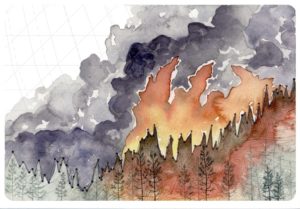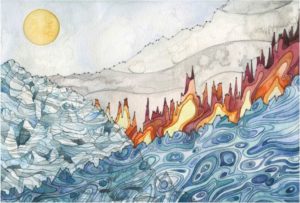What is trauma? From the perspective of many Western trauma theorists and somatic therapists such as Peter Levine and Bessel van der Kolk, trauma is energy that gets trapped in the body during and/or after a traumagenic experience. “Traumagenic” refers to anything that could cause trauma depending on a variety of individual factors such as one’s previous trauma, target identities, resilience tools, support systems, age, physical condition, etc. You and I might experience the same event but respond to it in very different ways. You could be traumatized and I could not be. Thus, the event is “traumagenic,” not traumatic.
imagine what happens if all of that energy
never leaves the body…
From this school of thought, what happens when a person has a traumagenic experience? The body takes a certain shape, a comportment of defensiveness, of protection. Meanwhile, the brain releases hormones that cause fight, flight or freeze reactions. The physical energy that moves through the body during these moments can literally lodge and get trapped anywhere in the body – in musculature, in joints, in organs, in the brain. Later on, when a person exhibits normal trauma responses such as physical pain, anxiety, terror, a need to control a situation, or any number of other emotional, physical, behavioral and psychological responses, it is neither the traumagenic experience nor the present trigger that is producing these responses but rather the blocked energy trying to move but having nowhere to go. For example, when attacked by someone violent, a person might take the shape of a sunken in, huddled body, protecting vital organs in the core. As the brain floods the body with fight/flight/freeze hormones, energy and neuromessages are sent throughout the body. If the person in this example does not discharge this energy, then they might walk through the world with their shoulders sunken forward, back hunched and senses easily hyper-aroused because they are stuck in the physical and psychological comportment of protection they took during the traumagenic experience.
Peter Levine’s critical research explored why animals, as opposed to so many humans who store trauma in their bodies, do not seem to live traumatized lives. He imagined that, since prey animals in particular live an unending series of traumagenic experiences, they must have some sort of mechanism for releasing trauma energy. Levine discovered that animals “discharge” trauma energy through movements and sounds such as shaking, snorting, deep breathing and cavorting. After a few minutes, off and away the animal goes, continuing its normal routines. Many humans do not do this – or I believe have forgotten how to do this – and so our trauma compounds until we do not even remember that we are traumatized, let alone where our trauma originates in our present lives and through intergenerational and cultural violence.
I recently was discussing intersections of landscape and trauma with a colleague who is a landscape architect. We talked about displacement and identity. We talked about how landscape architecture reflects the wounds of people through the structures it imposes in a place, and how landscape architecture could have the power to help people re-story and heal wounds of both humans and land. We talked about how human bodies are not separate from earth body. We discussed how human bodies can discharge trauma energy through shuddering, shaking, heaving and weeping, as well as through integrating with earth body.

An image came suddenly into my mind, an image that was utterly clear. I saw the earth body shuddering, shaking, heaving and weeping. What did it look like? Earthquakes and tsunamis, flood rains and fires, hurricanes and droughts. I realized in that moment that one way of understanding manifestations of climate change is that the Earth is processing the trauma of centuries of rape, pillage and exploitation in the forms of mining, drilling, fracking, toxic dumping, etc. And, one could say that the increased frequency of climate catastrophes correlates to the increased intensity of rape, pillage and exploitation of the planet since industrialization began. In no way do I mean to negate the importance of scientific data, particularly while living in a country in which my own president calls this data “fake news.” I hold science as real, just as I hold other ways of knowing to be equally – and sometimes more – real.

Western scientists like to say that the earth will regenerate long after humans have become extinct. Yes, she will – because she has not forgotten how to discharge trauma energy. She is doing it everyday, all over this planet. When, when, WHEN will we humans do this with her, en masse? I believe that if a significant revolution, a Great Turning as elder and teacher Joanna Macy calls it, is to occur on this planet, that social and political processes will only get us so far. Trauma healing must be part of this transformation.
PLEASE COMMENT! Your thoughts and responses? Other cultural perspectives on trauma, and particularly those that are not based in Western thought? I would love to dialogue with people about conceptions of trauma and trauma healing.
Relevant Resources:
Some communities and practitioners are working towards re-establishing human mechanisms for discharging trauma energy. Somatic Experiencing, Trauma Release Exercises and Reevaluation Counseling are a few examples.
For an example of how trauma discharge in animals works, watch this video. Note that this video includes what I consider to be cruelty to a polar bear who is the subject of the research.
Waking The Tiger (1997) by Peter Levine
The Body Keeps The Score (2014) by Bessel van der Kolk
Artwork by Jill Pelto, who communicates scientific climate change data through watercolors: http://www.jillpelto.com.

Cara, Your post describes so well my own need to “shake off” the icky, scary feelings I have around the climate change bearing down on me (all of us really). A good reminder for me to move more. I started to watch the polar bear video but turned it off right away because I knew it would be too sad for me to watch at the moment. I will share your thoughtful post today at our weekly session of Hearts in Action: Creative Responses to Climate Change. Free and open to all, by they way. Every Mon. 4-5pm through 11/27/17 (not meeting 11/20) in the Science and Engineering Library, UMass Amherst. Part of Talking Truth: Finding Your Voice Around the Climate Crisis. blogs.umass.edu/talkingtruth